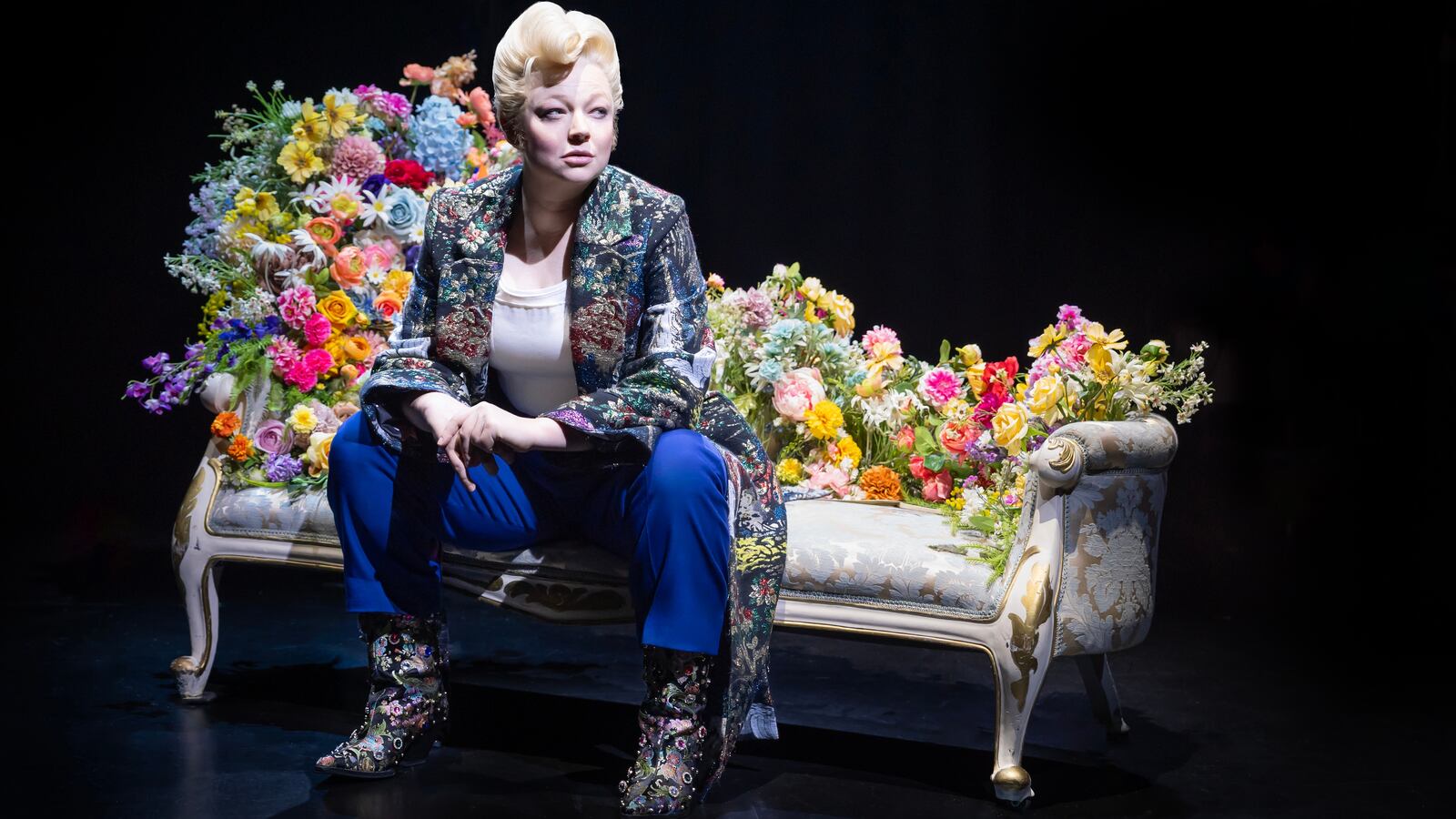—Oh gaadd, not more cameras and screens!
—Wow, these cameras and screens are integral!
And so my internal debate see-sawed throughout the mesmerizing, dazzling, and also exhausting The Picture of Dorian Gray (Music Box Theatre, booking to June 15), starring Succession’s Sarah Snook as 26 characters adapted from Oscar Wilde’s 1890 novella (later, the 1891 novel) by Kip Williams, who also directs this technically ingenious Broadway show.
Yet another transfer from ‘cross the pond, Dorian arrives garlanded with awards from London’s West End (where, both deservedly, Snook won an Olivier Award for her performance and Marg Horwell for the show’s striking costuming; Horwell also designed the show itself).
Snook plays these 26 male and female characters vitally aided by David Bergman’s video design; the latter is so integral it deserves equal lead billing. Snook could not execute her performance without the conjured presence of all the other characters she inhabits through Bergman’s tech prowess.
Multiple screens ascend and descend around the stage with pre-taped segments of characters in various states of discussion with the live Snook on stage, narrating or playing a character—perfectly angled and directed to interact with herself playing another character on a screen/screens.

There are scenes with multiple Snooks playing multiple characters on a screen, with the real Snook alongside them in the theater sitting at the end of an actual table. In a couple of moments, Snook playing the narrator on stage clashes with Snook-as-Snook on camera, each wanting to narrate—with the Snook on camera leaving her other self on stage to get on with it.
In the show’s Playbill, Williams said this staging was rooted in “two core provocations” of Wilde’s novel—first, that “a human [is] a being with myriad lives and myriad sensations, a complex multiform creature.” Also, “that life itself is one grand act of theatre, one where we are all engaged in perpetual acts of performance in order that we might reveal or conceal our truth.”
Dorian is immaculately choreographed theater-meets-film, with just as critical support from stage manager Lisa Iacucci, Nick Schlieper (lighting), Clemence Williams (composer and sound design), and company manager Justin Gleiberman.
On stage—a mostly bare tundra, with screens hanging as barriers, and occasional shuttled-in-then-dismantled micro-sets—Snook and the tech-manipulated Snooks whirl from one scene to another.
The physically on-stage Snook is accompanied by a team of camera operators: clew, Luka Kain, Natalie Rich, Benjamin Sheen (the camera captain), Dara Woo, Will Colacito, and Benjamin Wheelwright. The group are like a shoal of fish, involved in a constant collective churn of movement—indeed sometimes the intrinsic ballet of what they are doing becomes actual dance routines. This is amazing to watch, but the practical execution of the show can overshadow the story it is trying to tell.

The title character of Wilde’s book is so desperate to hold on to his youth that he gives up his soul; in exchange for his own eternal youth, a portrait of himself locked up in an attic ages. Dorian’s obsession leads to all-round decadence and ultimately unhappiness, suicide, and murder. With so many Snooks and so many characters, the characters can get a little scrambled; and whatever high-minded aims belie the show, you’re really there watching Snook execute two hours of impressive, theatrical high-trapeze.
Her drag king dressing-up box, and variously funny and disturbing character transitions, are stunningly realized; she’s a one-person polyphony—lavishly self-glorifying as Dorian one moment, then infatuated and unnerved as artist Basil Hallward the next, then urbane and louche as Lord Henry Wotton. Slowly, Snook’s stage narrator becomes subsumed by Snook’s Dorian.
The show’s aesthetic and staging melds with the themes of the book—Dorian’s destructive vanity, and the novella’s obsessions with artifice, aesthetics and art, chime with every close-up camera angle and how the show itself is crafted. A construction of personal artifice is the vehicle for a story about the construction of personal artifice, and Snook makes a witty meal of all the roles.
We see Dorian’s obsession with aging play out as an all-consuming obsession with his looks. His pouting, preening gaze is in thrall to the camera; in one striking sequence, he takes selfies of himself, applying cellphone technology to sharpen cheekbones and grotesquely plump-up lips.
This is a piece that, like Sunset Boulevard, revels in its workings as a piece of theater alongside the source text it is animating. Its camera crew is not the only echo of Sunset; as with Tom Francis’ top-of-Act-Two sequence in that show, we also follow Snook off-stage into the bowels of the theater to an imagined nightclub (but not out onto the street).
Little breakout stage areas bloom out of the gloam of the empty stage—like the attic where the portrait is kept, and a theater with puppets showing Dorian’s ill-fated courtship of actress Sybil Vane. The staging mashes up Victorian smoking jackets with the on-stage cameras placing us in the very present day, and pop tracks including “I Feel Love.” History and eras, past and present, are blurred.
The Snooks-x-26 facial gymnastics are always transfixing (from gurning to simpering to pouting to panicking to flirting to anger to unnervingly staring to vampirically seducing); the camera is trained on her in close-up as herself-as-other characters objectify the eternally self-loving Dorian.
From the bubble-curled Tadzio-lite we first meet, the final Dorian resembles a platinum-bouffant, bloaty Elvis. Just as in the cross-gender roles of Operation Mincemeat, a female actor inhabiting male characters can uncloak masculinity and male fallibilities in implicitly mischievous ways.
Beyond the traditional bounds of Wildean languid camp, Snook’s characterizations—played direct to camera—possess a kind of ambiguous meta-camp, with Snook both quizzically and archly interacting with the text’s inherent, yet unspoken, themes of queerness and same-sex desire.
There are only a few moments where Snook is alone center stage with no cameras, delivering lines as if in a conventional play. When it happens it’s a shock—so focused we have been on all the screens, and on the many feats of technical trickery the production excels in. Here, finally, is Snook simply acting, and instead of the screens-as-familiar-accessory-and-crutch, the audience has to pay a more traditional kind of attention.
Such rare moments are necessarily exposing for the character, and a welcome splash of cold water for us watching. I wished there had been more of them throughout, Snook simply acting unencumbered by camera operators and the show’s whizz-bang technology.

While the cameras and screens are used ingeniously, their predominance also nourishes a spoon-fed visual laziness we know all too well surrounded by screens all day every day. There is no disputing their technically accomplished use in The Picture of Dorian Gray, and the general dazzle of the show, but what do they help reveal of Wilde’s text that is new or revelatory? Not much. We simply wait for the next where-are-all-the-Snooks-now? set-up.
One of the joys of live theater—with actors acting, and audience members collectively, actively watching—is that for those few hours we are free of screens, our senses forced to respond independently of them.
And yet—another splash of cold water—Dorian Gray absolutely aces its use of technology, and Snook has been rightly awarded and applauded for her masterful cavalcade. All 26 Snooks are more than ready for their close-up.









